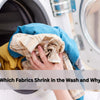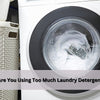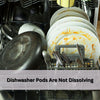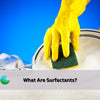How to Conserve Water While Hand-Washing Dishes: Tips for Using Less Water
- by Brodie Cook
Washing dishes is a daily chore that can use a lot of water, but it doesn’t have to. With a few simple changes, you can make your dishwashing routine more eco-friendly and water-efficient. Whether you wash dishes by hand or use products like Lucent Globe’s dishwashing sheets, there are plenty of ways to cut down on water when washing and help our environment.
Here are five easy steps to help you conserve water while keeping your dishes sparkling clean.
What You Need to Wash Dishes by Hand with Minimal Water
To get your dirty dishes clean while conserving water, you’ll need a few essential items. Here’s a list to help you get started:
- Water
- Dirty dishes
- Wooden or silicone spatula or something else that can be used for scraping
- Sponge or brush (for scrubbing)
- Warm water preferrably
- Biodegradable dish soap
- Basin or sink
- Drying rack or towel
Having these items on hand will make the process of washing dishes by hand efficient and eco-friendly. Using warm water, a good sponge, and biodegradable soap ensures your dishes get clean while you use as little water as possible. A drying rack or towel will help you finish the job without wasting extra water.
Step 1: Scrape and Prep

Use a wooden or silicone spatula to scrape off any leftover food from your dirty dishes before you start washing. This step helps reduce the amount of water needed and prevents food from clogging that normally would go down the drain. It’s quick and easy, and it makes a big difference in conserving water.
Scraping off food also makes washing your dishes faster and easier. You'll spend less time scrubbing and more time enjoying a clean kitchen. So, grab your spatula and give your dishes a quick scrape before you start washing.
Tip: Keep a small compost bin or food scrap container nearby to collect the scraps you scrape off. This makes it easy to dispose of food waste in an eco-friendly way and keeps your kitchen tidy.
Step 2: Use Warm Water Wisely
Pre-rinse using warm water to help loosen and remove food particles more effectively. Warm water can break down grease and food residues faster, making the washing process quicker and more efficient.
Start with warm water to rinse and scrub your dishes. This helps to get rid of stubborn food bits and makes your dishwashing easier. Use your hand to wipe the dishes. Remember, to turn off the water as you don't need to keep the water running the whole time. A little warm water goes a long way in getting your dishes clean.
If warm water isn't available somehow, cold (room temperature) water should also be fine but it will be harder to remove the greasy stuff.
Tip: To save energy, you can heat a small amount of water in a kettle your tap doesn’t provide warm water quickly. This way, you can still benefit from the effectiveness of warm water without using too much while waiting for it to heat up at the tap.
Step 3: Turn Off the Tap

Fill a basin or the sink with a few inches of soapy water. Turn off the tap while you scrub your dishes. This simple step saves much water! Like a lot!
Start by soaking your dishes briefly if needed. This helps to loosen any tough food particles. Then, scrub your dishes using a sponge or scrubber. The soapy water will do the job without wasting gallons of water down the drain.
Here’s a priority list for what to wash first:
- Glasses and Utensils: Dishes like these are usually less greasy and will keep the water cleaner.
- Plates and Bowls: Move on to these next, as they may have more residue but are still manageable.
- Pots and Pans: Save these for last since they tend to be the greasiest and can dirty the water quickly.
Use Lucent Globe’s dishwashing sheets over the traditional detergent. These sheets dissolve quickly in water, creating the perfect amount of soap suds to clean your dishes effectively. They’re biodegradable and free from harsh chemicals, making them safe for you and the environment.
By turning off the tap and using Lucent Globe’s dishwashing sheets, you use just enough water to get your dishes clean. It’s easy because you will use less water to wash the soap away and still have sparkling dishes. Remember, every little bit helps when it comes to saving water and protecting our planet.
If you’re washing a lot of dishes, consider setting up a two-basin system. Use one basin with soapy water for washing and another with clean water for rinsing. This method ensures you’re using minimal water while still getting your dishes thoroughly clean.
Step 4: Rinse Smartly

Rinse your soapy dishes in small batches using a low, steady stream of running water. This method helps save water and ensures each dish is thoroughly rinsed.
By rinsing in small batches, you make sure you’re using just enough water to get your dishes clean without wasting any. It’s an efficient way to wash dishes, and it helps conserve water.
Alternatively you can fill the sink (or big bowl) with rinse water. Use that water to remove the soap from the dishes, and only replace the water when it becomes too soapy.
Dry on a Rack

Place the clean dishes on a drying rack to air dry. This method is efficient and eco-friendly, as it saves you from using extra towels and wasting water instead. Air drying also helps prevent the spread of bacteria that can occur with damp towels. Letting your dishes dry naturally not only conserves water but also keeps them spotless and ready for their next use.
Tips and Tricks for Water Conservation
- Keep the Dishes Close: Arrange dishes near the sink to minimise faucet running time.
- Use the Right Amount of Dish Soap: Too much soap requires more water to wash away the larger amount of soap, remember to only add a little to each wash.
- Drip Dry: Let your dishes air dry on a rack to save on towel drying and additional rinsing.
- Pre-Soak for Stubborn Stains: Soak cookware with stubborn stains in minimal water overnight to ease cleaning.
FAQ about washing dishes
Is it less water to wash dishes by hand or dishwasher?
The amount of water used to wash dishes can vary greatly depending on the method, efficiency of the person washing them and the load of dishes needing to be washed. Here are some key points:
Dishwasher:
- Water Usage: Energy Star-rated dishwashers use about 3.5 gallons (13.2 litres) of water per load of 144 items. (source: thewiredshopper.com)
- Efficiency: Dishwashers are generally more water-efficient if used correctly, such as running full loads and using the eco-setting.
Hand Washing:
- Water Usage: Hand-washing dishes can use significantly more water if the tap is left running. On average, washing the same load of 144 items by hand uses about 100 litres of water (source: study by the University of Bonn in Germany)
- Efficiency: Don't have a dishwasher? Hand washing can be water-efficient when washing with proper techniques like using a basin, turning off the tap while scrubbing, and rinsing dishes in batches.
What is the most economical way to wash dishes?
Using a dishwasher is more economical than hand washing, especially with Lucent Globe detergent sheets at $0.30 per wash. Dishwashers use less water (10-15 liters) and energy (1-2 kWh) per load compared to hand washing (up to 100 liters) for 144 items.. This method also saves time and effort, making it the more efficient choice for regular dishwashing.

 Dishwashing
Dishwashing Laundry
Laundry Bundles
Bundles Surfaces
Surfaces Toilet
Toilet Handsoap
Handsoap Multi-Purpose
Multi-Purpose Floor
Floor



